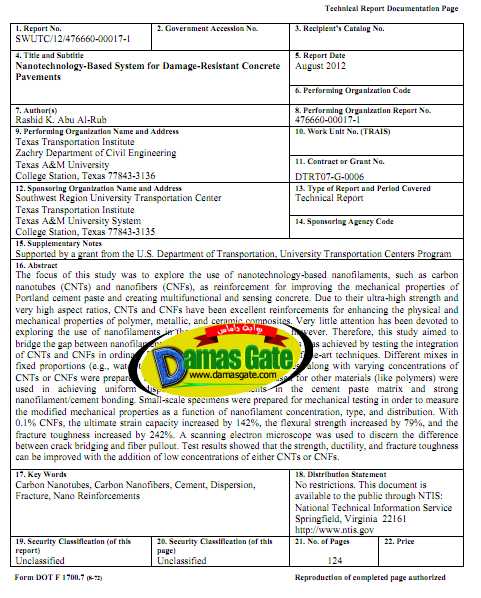Nanotechnology Based system for Damage Resistant COncrete Pavements

1.1 Problem Statement
1. INTRODUCTION
It is well known that concrete is the most used and produced manmade material. The importance of this fundamental material motivates scientists and engineers to investigate and study the properties and behavior of cementitious materials in order to have a better understanding and to improve their mechanical properties, such as strength, ductility, and toughness. Concrete is a brittle material that has low tensile strength, low ductility, and early development and propagation of micro-cracks due to shrinkage. Beginning as early as the 1980s, fiber-reinforced concrete (FRC), using macro fibers as reinforcements, was used to improve the tensile strength, ductility, and toughness of concrete. However, the gain in ductility was obtained for the fiber-reinforced concrete as a composite, not for the concrete itself as a cementitious material. Recently, a wide range of reinforcements, at macro, meso, and micro scales, has been used to control the early stages of crack propagations within cementitious materials [1-7]. Reinforcing cementitious materials has varied from using macro fibers, like steel reinforcement rebar that is continuously aligned along the tensile material fibers of the cementitious element, to discrete micro and nanofibers, like microfibers, carbon nanofibers (CNFs), and carbon nanotubes (CNTs).
The motivation of using these nanofilaments is based on their unique characteristics. The nano scale of the CNTs and CNFs reduces the defects in their molecular structure as well as increases their surface-to-volume ratio. This unique structure allows carbon nanotubes to have extraordinary mechanical, electrical, thermal, and chemical properties that make them promising filaments for many engineering materials and applications [8, 9]. CNTs and CNFs have shown great potential as reinforcements for polymer-based materials [10-12].
In the last few years, scientists and researchers have started to investigate and implement the use of these nanofilaments—CNTs and CNFs—in reinforcing concrete. The idea behind using the CNTs and CNFs is their potential to control and prevent the nucleation of cracks at the nano scale by the crack-bridging mechanism, hence preventing the growth and propagation of the cracks to a larger scale. This would result in high-performance cementitious materials, with higher stiffness and durability.
Download
*